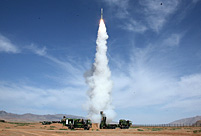TOKYO, Sept. 19 -- Japan's Prime Minister Shinzo Abe on Thursday ordered the decommissioning of two more reactors at the tsunami-ravaged Fukushima Daiichi nuclear facility and pledged to take responsibility for the massive cleanup operations and toxic leaks, as revelations emerged the leaks were preventable.
On his second trip to the stricken facility since assuming office, Abe said he would stand by promises made to the International Olympic Committee (IOC) to ensure a safe Summer Olympics in Tokyo in 2020, local media reported.
According to the reports, Abe also said he wanted to allay mounting global concerns about contaminated water leaking from the plant into the adjacent Pacific Ocean and had instructed the plant 's embattled operator Tokyo Electric Power Co. (TEPCO) to adhere to a new timeframe to deal with the radioactive leaks.
Abe told TEPCO officials that for them to prioritize the fixing of potentially multiple leaking tanks storing contaminated water, which is accumulating at a rate of around 400 tons per day, the plant would have to decommission the No. 5 and No. 6 reactors that are currently shuttered.
On March 11, 2011, the Daiichi facility in Japan's northeast was battered by a massive earthquake-triggered tsunami that caused multiple meltdown in four of the plant's reactors, leading to radioactive materials spreading into the air, ground and sea in the worst nuclear disaster since Chernobyl in 1986.
The No. 5 and No. 6 reactors were damaged by the tsunami, but didn't suffer full-blown meltdowns, but have remained offline since the crisis nevertheless.
Abe said that TEPCO chief Naomi Hirose pledged to review the decommissioning of the two reactors by the end of the year, but sources familiar with the matter said Thursday that the cash- strapped utility may push to keep the reactors on-site to boost their balance sheet.
The sources said that following TEPCO's losses of 27 billion U. S. dollars since the initial disaster, the utility is in talks with banks about refinancing terms to the tune of around 816 million U.S. dollars expected in October.
Abe, during his tour of the plant Thursday, also inspected the utility's efforts to contain leaks of radioactive water from temporary storage tanks. There are around 1,000 steel storage tanks on the site, but the massive daily influx of water needed to cool the stricken reactors' nuclear fuel rods, has meant the tanks are at near capacity.
Japan's nuclear watchdog and the International Atomic Energy Agency (IAEA) have urged TEPCO to expedite the decontamination of the water so it can be released into the Pacific Ocean, fearing that if the process is delayed any further, the utility will be forced to release untreated, highly-contaminated water into the ocean to make room for more ever-accumulating toxic water.
Abe instructed TEPCO to prioritize the leaking tanks and said his administration would be responsible for controlling the issue and the subsequent cleanup operations.
The Japanese government has pledged around 470 million U.S. dollars in emergency funding to TEPCO, with some of the funds earmarked for the construction of frozen walls under the reactors to prevent contaminated substances escaping through groundwater and into the ocean.
As the utility struggles to contain the leaks from the wrecked plant and with the "ice wall" having never been tested on a scale the size of the Fukushima crisis, sources close to the matter revealed Thursday that U.S. nuclear experts advised TEPCO and the government to build barriers around the reactors as a preventative measure to leaks, more than two years ago.
The advice from the experts was provided to the Japanese government two months after the tsunami knocked out the plant's key cooling functions, leading to the catastrophic meltdowns.
The U.S. Nuclear Regulatory Commission (NRC) urged TEPCO to construct emergency barriers following the disaster, but the utility rejected the idea due to the financial burden it would have to shoulder and for fears that investor confidence would be dashed on insolvency fears.
The NRC's plans, first discussed with TEPCO in April 2011, put forward comprehensive measures for the utility to ensure that contaminated groundwater remains contained and that long-term groundwater monitoring and decontamination protocols were implemented by TEPCO following the NRC's expert advice.
As well as lobbying to not build the much-needed barriers at the earliest possible juncture, TEPCO also requested in a memo -- reviewed and confirmed by two major media sources -- that the government refrain from going public with the vetoed plans to build emergency barriers, for fears of unsettling financial markets.
The latest revelation doesn't bode well for the utility or the government, and both have come under fire for a lack of transparency regarding the crisis at the Fukushima plant, since the tsunami struck.
In addition to misreporting vital radiation levels at trenches near tanks suspected of leaking contaminated water, TEPCO for months also denied that radioactive water was flowing into the ocean.
The utility finally admitted last month that 300 tons of radioactive water had leaked into the ocean from a storage tank that was shoddily constructed. Japan's nuclear watchdog subsequently blasted the utility for their rudimentary patching up of the tank's leak.
Despite the string of coverups and gaffe's by TEPCO, much to the ire of the global community, Abe on Thursday promised that the treating of contaminated water being stored at the plant would be completed by March 2015.
 Pakistan suffers desperate shortage of water
Pakistan suffers desperate shortage of water New model of indigenous surface-to-air missiles testfired
New model of indigenous surface-to-air missiles testfired  Heritage train ride across western Kosovo
Heritage train ride across western Kosovo Baby girl 'too young' for birthmarks treatment
Baby girl 'too young' for birthmarks treatment Beijing court hears airport blast case
Beijing court hears airport blast case Harbin named Chinese city with most beautiful women
Harbin named Chinese city with most beautiful women Wushu spirit
Wushu spirit Rugby girls
Rugby girls Funniest photos of sport stars as kids
Funniest photos of sport stars as kids  Residences of the royal house of Savoy
Residences of the royal house of Savoy China's frigate 'Bengbu'in fire training
China's frigate 'Bengbu'in fire training The last days of Wan Aihua
The last days of Wan Aihua Highlights at 12th National Games of China
Highlights at 12th National Games of China Beijing Film Academy welcomes freshmen
Beijing Film Academy welcomes freshmen 2013 Taiwan Int'l Tourism Expo kicks off in Taipei
2013 Taiwan Int'l Tourism Expo kicks off in TaipeiDay|Week|Month